Financial Modeling: Excel, Models, and Valuation Techniques
VerifiedAdded on 2019/09/30
|19
|3515
|137
Report
AI Summary
This report provides a comprehensive overview of financial modeling, detailing its importance, objectives, and applications in finance. It explores various aspects, including financial statement analysis, valuation techniques such as discounted cash flow (DCF), leveraged buyout (LBO), merger and acquisition (M&A) analysis, and comparable company analysis. The report emphasizes the use of Excel in building financial models, covering the three-statement model (income statement, balance sheet, and cash flow statement), supporting schedules, and techniques for forecasting and scenario analysis. It also covers important topics such as credit rating, ratio analysis, and the importance of financial modeling in corporate decision-making, risk management, and investment analysis. The report also examines different types of financial models, including the three-statement model, discounted cash flow model, and leveraged buyout model, providing insights into their methodologies and applications in financial planning and analysis.

Course topics
1
1
Paraphrase This Document
Need a fresh take? Get an instant paraphrase of this document with our AI Paraphraser
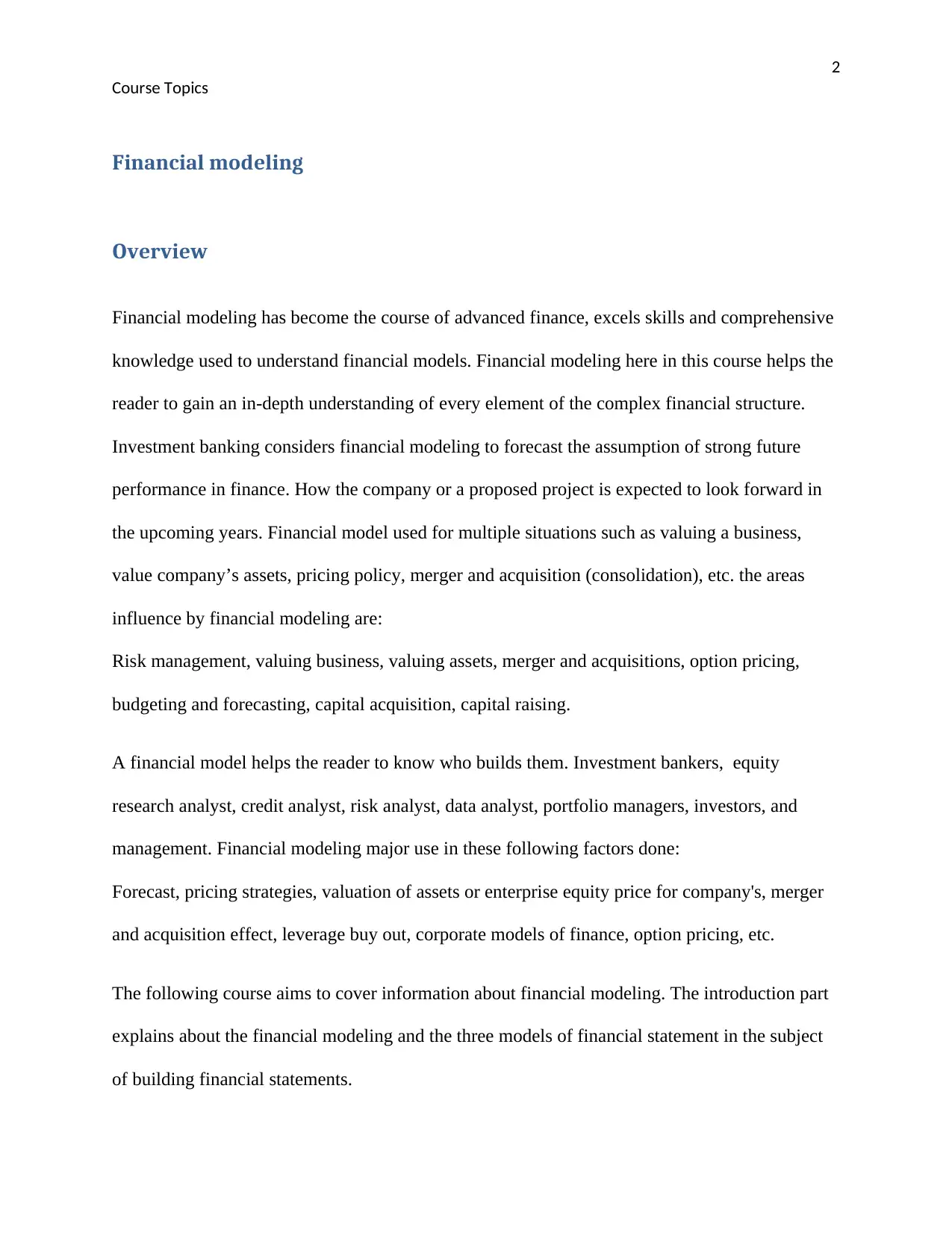
2
Course Topics
Financial modeling
Overview
Financial modeling has become the course of advanced finance, excels skills and comprehensive
knowledge used to understand financial models. Financial modeling here in this course helps the
reader to gain an in-depth understanding of every element of the complex financial structure.
Investment banking considers financial modeling to forecast the assumption of strong future
performance in finance. How the company or a proposed project is expected to look forward in
the upcoming years. Financial model used for multiple situations such as valuing a business,
value company’s assets, pricing policy, merger and acquisition (consolidation), etc. the areas
influence by financial modeling are:
Risk management, valuing business, valuing assets, merger and acquisitions, option pricing,
budgeting and forecasting, capital acquisition, capital raising.
A financial model helps the reader to know who builds them. Investment bankers, equity
research analyst, credit analyst, risk analyst, data analyst, portfolio managers, investors, and
management. Financial modeling major use in these following factors done:
Forecast, pricing strategies, valuation of assets or enterprise equity price for company's, merger
and acquisition effect, leverage buy out, corporate models of finance, option pricing, etc.
The following course aims to cover information about financial modeling. The introduction part
explains about the financial modeling and the three models of financial statement in the subject
of building financial statements.
Course Topics
Financial modeling
Overview
Financial modeling has become the course of advanced finance, excels skills and comprehensive
knowledge used to understand financial models. Financial modeling here in this course helps the
reader to gain an in-depth understanding of every element of the complex financial structure.
Investment banking considers financial modeling to forecast the assumption of strong future
performance in finance. How the company or a proposed project is expected to look forward in
the upcoming years. Financial model used for multiple situations such as valuing a business,
value company’s assets, pricing policy, merger and acquisition (consolidation), etc. the areas
influence by financial modeling are:
Risk management, valuing business, valuing assets, merger and acquisitions, option pricing,
budgeting and forecasting, capital acquisition, capital raising.
A financial model helps the reader to know who builds them. Investment bankers, equity
research analyst, credit analyst, risk analyst, data analyst, portfolio managers, investors, and
management. Financial modeling major use in these following factors done:
Forecast, pricing strategies, valuation of assets or enterprise equity price for company's, merger
and acquisition effect, leverage buy out, corporate models of finance, option pricing, etc.
The following course aims to cover information about financial modeling. The introduction part
explains about the financial modeling and the three models of financial statement in the subject
of building financial statements.
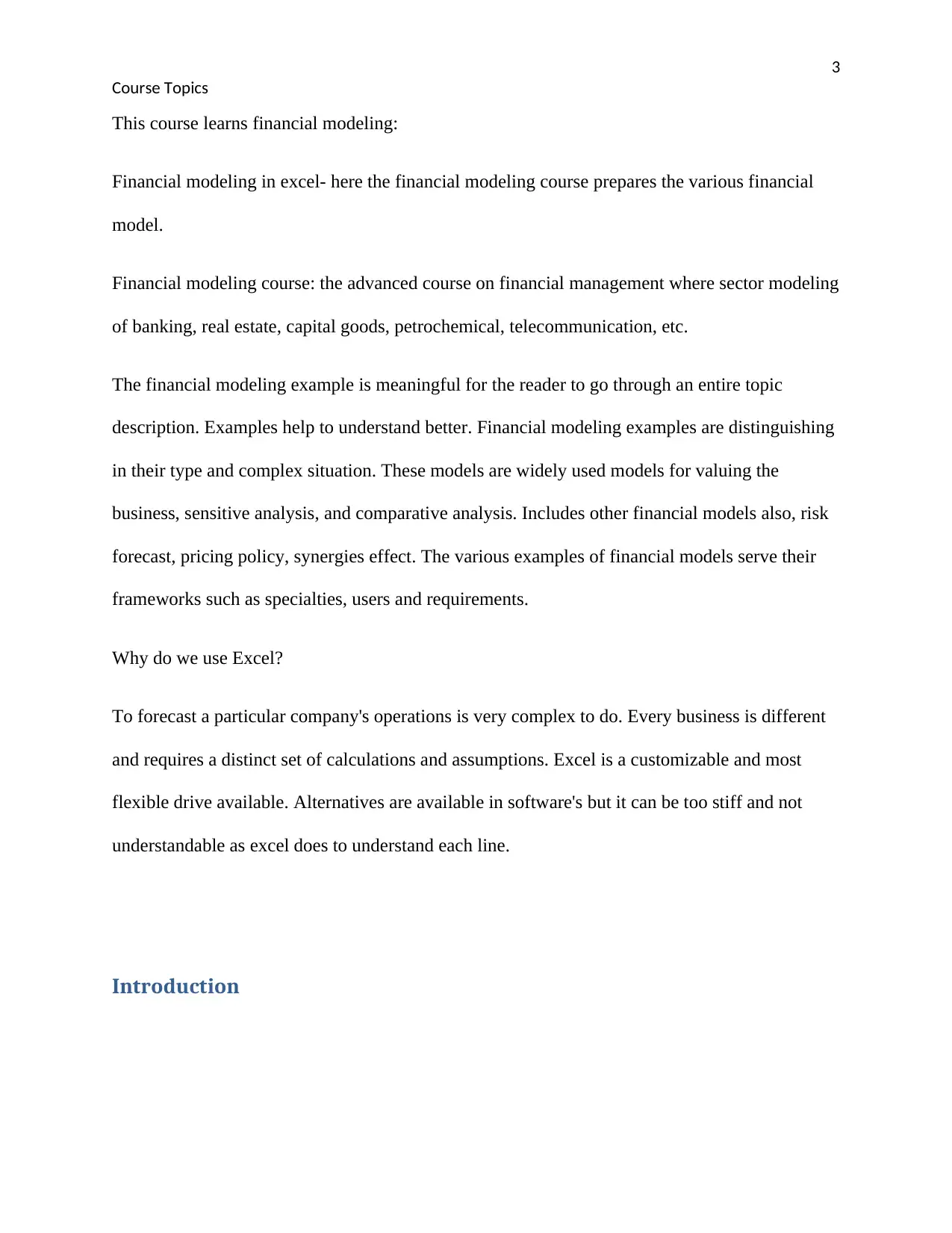
3
Course Topics
This course learns financial modeling:
Financial modeling in excel- here the financial modeling course prepares the various financial
model.
Financial modeling course: the advanced course on financial management where sector modeling
of banking, real estate, capital goods, petrochemical, telecommunication, etc.
The financial modeling example is meaningful for the reader to go through an entire topic
description. Examples help to understand better. Financial modeling examples are distinguishing
in their type and complex situation. These models are widely used models for valuing the
business, sensitive analysis, and comparative analysis. Includes other financial models also, risk
forecast, pricing policy, synergies effect. The various examples of financial models serve their
frameworks such as specialties, users and requirements.
Why do we use Excel?
To forecast a particular company's operations is very complex to do. Every business is different
and requires a distinct set of calculations and assumptions. Excel is a customizable and most
flexible drive available. Alternatives are available in software's but it can be too stiff and not
understandable as excel does to understand each line.
Introduction
Course Topics
This course learns financial modeling:
Financial modeling in excel- here the financial modeling course prepares the various financial
model.
Financial modeling course: the advanced course on financial management where sector modeling
of banking, real estate, capital goods, petrochemical, telecommunication, etc.
The financial modeling example is meaningful for the reader to go through an entire topic
description. Examples help to understand better. Financial modeling examples are distinguishing
in their type and complex situation. These models are widely used models for valuing the
business, sensitive analysis, and comparative analysis. Includes other financial models also, risk
forecast, pricing policy, synergies effect. The various examples of financial models serve their
frameworks such as specialties, users and requirements.
Why do we use Excel?
To forecast a particular company's operations is very complex to do. Every business is different
and requires a distinct set of calculations and assumptions. Excel is a customizable and most
flexible drive available. Alternatives are available in software's but it can be too stiff and not
understandable as excel does to understand each line.
Introduction
⊘ This is a preview!⊘
Do you want full access?
Subscribe today to unlock all pages.

Trusted by 1+ million students worldwide
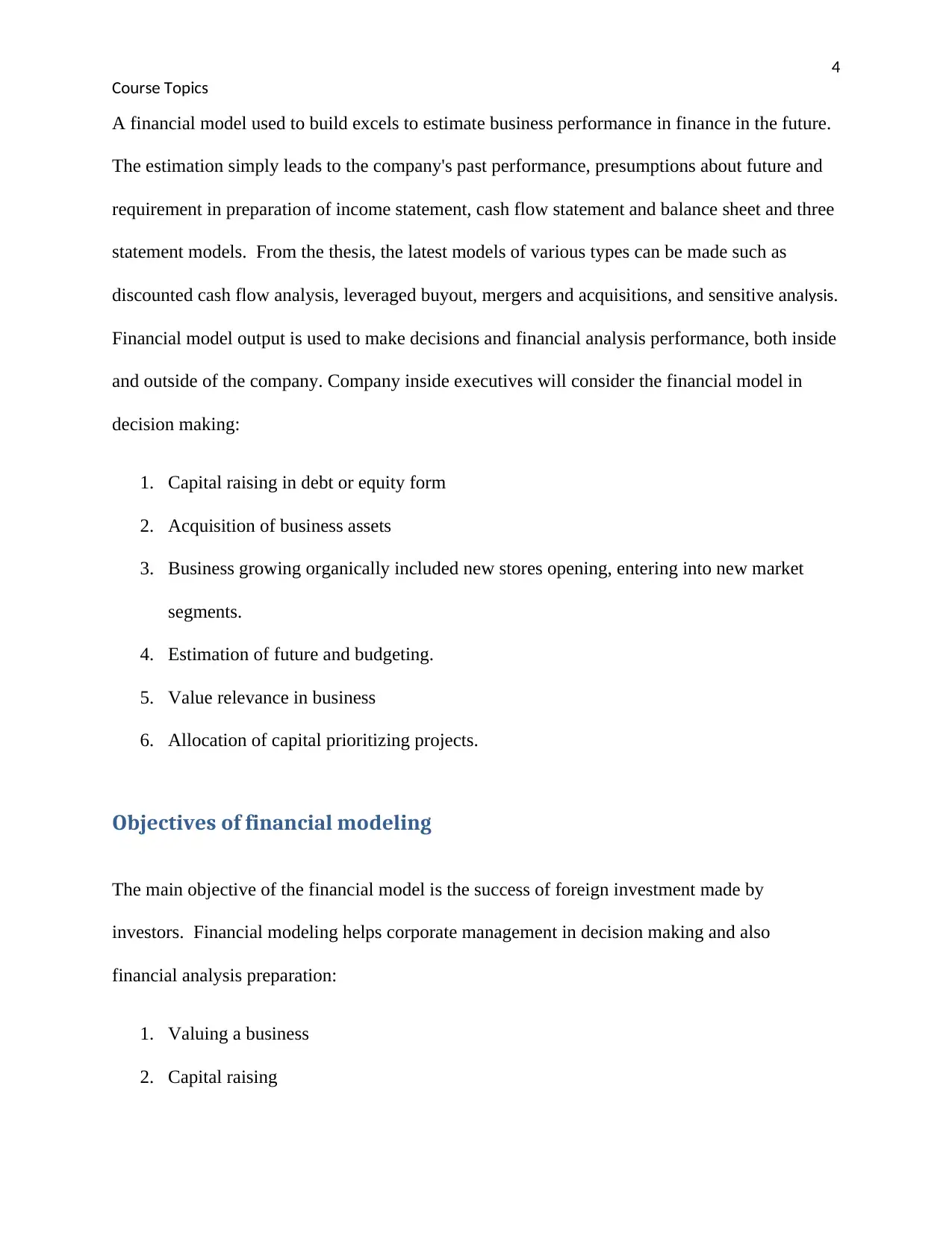
4
Course Topics
A financial model used to build excels to estimate business performance in finance in the future.
The estimation simply leads to the company's past performance, presumptions about future and
requirement in preparation of income statement, cash flow statement and balance sheet and three
statement models. From the thesis, the latest models of various types can be made such as
discounted cash flow analysis, leveraged buyout, mergers and acquisitions, and sensitive analysis.
Financial model output is used to make decisions and financial analysis performance, both inside
and outside of the company. Company inside executives will consider the financial model in
decision making:
1. Capital raising in debt or equity form
2. Acquisition of business assets
3. Business growing organically included new stores opening, entering into new market
segments.
4. Estimation of future and budgeting.
5. Value relevance in business
6. Allocation of capital prioritizing projects.
Objectives of financial modeling
The main objective of the financial model is the success of foreign investment made by
investors. Financial modeling helps corporate management in decision making and also
financial analysis preparation:
1. Valuing a business
2. Capital raising
Course Topics
A financial model used to build excels to estimate business performance in finance in the future.
The estimation simply leads to the company's past performance, presumptions about future and
requirement in preparation of income statement, cash flow statement and balance sheet and three
statement models. From the thesis, the latest models of various types can be made such as
discounted cash flow analysis, leveraged buyout, mergers and acquisitions, and sensitive analysis.
Financial model output is used to make decisions and financial analysis performance, both inside
and outside of the company. Company inside executives will consider the financial model in
decision making:
1. Capital raising in debt or equity form
2. Acquisition of business assets
3. Business growing organically included new stores opening, entering into new market
segments.
4. Estimation of future and budgeting.
5. Value relevance in business
6. Allocation of capital prioritizing projects.
Objectives of financial modeling
The main objective of the financial model is the success of foreign investment made by
investors. Financial modeling helps corporate management in decision making and also
financial analysis preparation:
1. Valuing a business
2. Capital raising
Paraphrase This Document
Need a fresh take? Get an instant paraphrase of this document with our AI Paraphraser
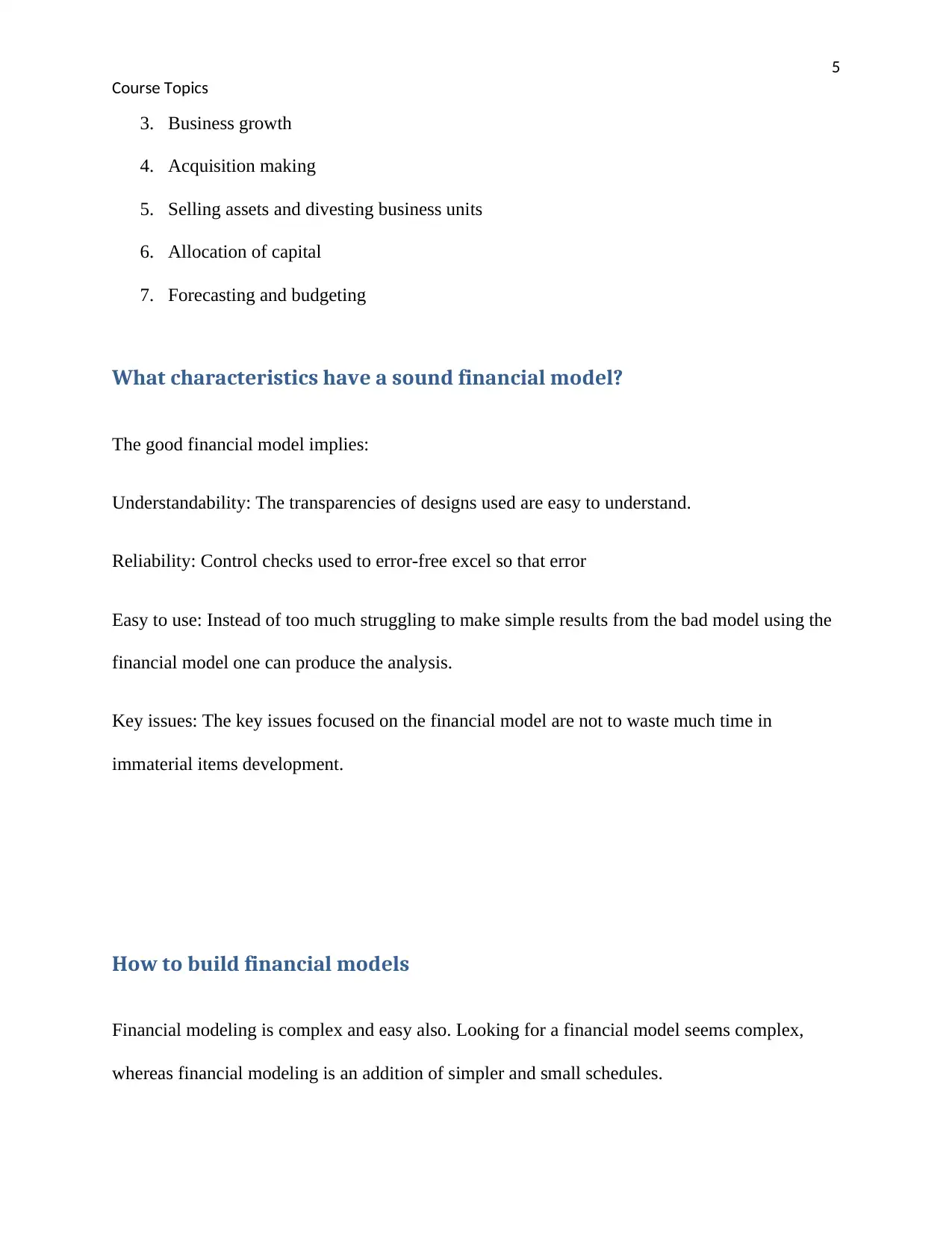
5
Course Topics
3. Business growth
4. Acquisition making
5. Selling assets and divesting business units
6. Allocation of capital
7. Forecasting and budgeting
What characteristics have a sound financial model?
The good financial model implies:
Understandability: The transparencies of designs used are easy to understand.
Reliability: Control checks used to error-free excel so that error
Easy to use: Instead of too much struggling to make simple results from the bad model using the
financial model one can produce the analysis.
Key issues: The key issues focused on the financial model are not to waste much time in
immaterial items development.
How to build financial models
Financial modeling is complex and easy also. Looking for a financial model seems complex,
whereas financial modeling is an addition of simpler and small schedules.
Course Topics
3. Business growth
4. Acquisition making
5. Selling assets and divesting business units
6. Allocation of capital
7. Forecasting and budgeting
What characteristics have a sound financial model?
The good financial model implies:
Understandability: The transparencies of designs used are easy to understand.
Reliability: Control checks used to error-free excel so that error
Easy to use: Instead of too much struggling to make simple results from the bad model using the
financial model one can produce the analysis.
Key issues: The key issues focused on the financial model are not to waste much time in
immaterial items development.
How to build financial models
Financial modeling is complex and easy also. Looking for a financial model seems complex,
whereas financial modeling is an addition of simpler and small schedules.
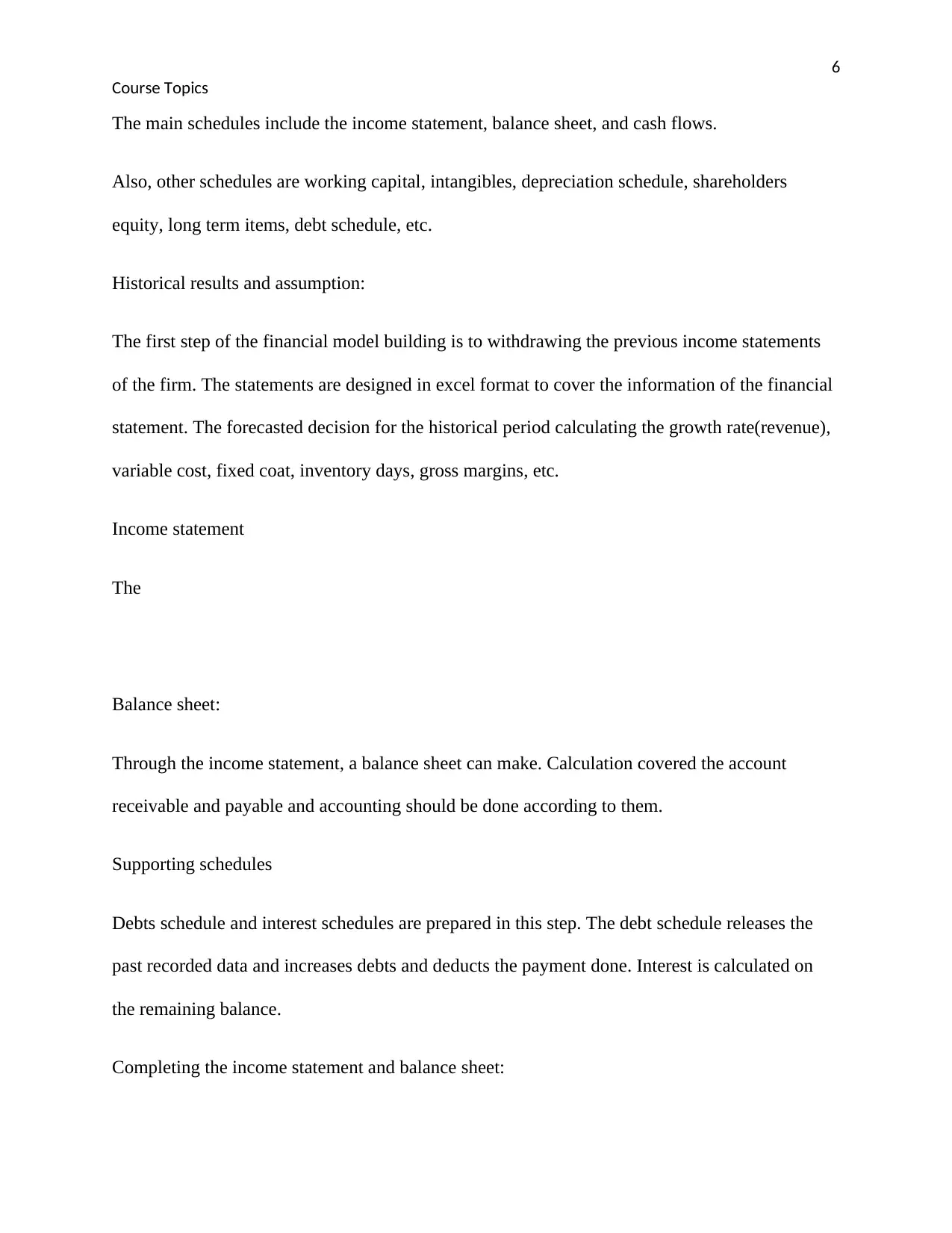
6
Course Topics
The main schedules include the income statement, balance sheet, and cash flows.
Also, other schedules are working capital, intangibles, depreciation schedule, shareholders
equity, long term items, debt schedule, etc.
Historical results and assumption:
The first step of the financial model building is to withdrawing the previous income statements
of the firm. The statements are designed in excel format to cover the information of the financial
statement. The forecasted decision for the historical period calculating the growth rate(revenue),
variable cost, fixed coat, inventory days, gross margins, etc.
Income statement
The
Balance sheet:
Through the income statement, a balance sheet can make. Calculation covered the account
receivable and payable and accounting should be done according to them.
Supporting schedules
Debts schedule and interest schedules are prepared in this step. The debt schedule releases the
past recorded data and increases debts and deducts the payment done. Interest is calculated on
the remaining balance.
Completing the income statement and balance sheet:
Course Topics
The main schedules include the income statement, balance sheet, and cash flows.
Also, other schedules are working capital, intangibles, depreciation schedule, shareholders
equity, long term items, debt schedule, etc.
Historical results and assumption:
The first step of the financial model building is to withdrawing the previous income statements
of the firm. The statements are designed in excel format to cover the information of the financial
statement. The forecasted decision for the historical period calculating the growth rate(revenue),
variable cost, fixed coat, inventory days, gross margins, etc.
Income statement
The
Balance sheet:
Through the income statement, a balance sheet can make. Calculation covered the account
receivable and payable and accounting should be done according to them.
Supporting schedules
Debts schedule and interest schedules are prepared in this step. The debt schedule releases the
past recorded data and increases debts and deducts the payment done. Interest is calculated on
the remaining balance.
Completing the income statement and balance sheet:
⊘ This is a preview!⊘
Do you want full access?
Subscribe today to unlock all pages.

Trusted by 1+ million students worldwide
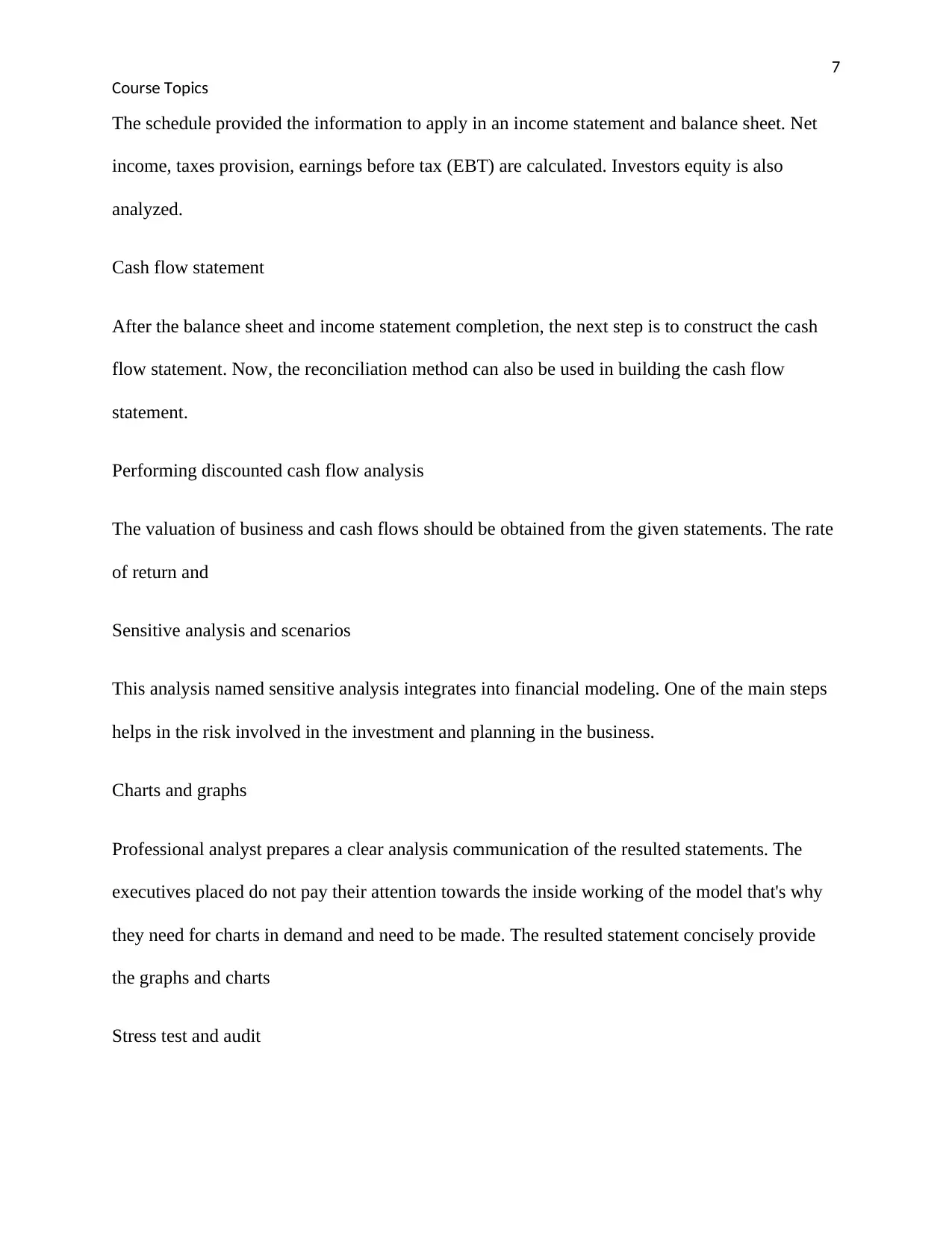
7
Course Topics
The schedule provided the information to apply in an income statement and balance sheet. Net
income, taxes provision, earnings before tax (EBT) are calculated. Investors equity is also
analyzed.
Cash flow statement
After the balance sheet and income statement completion, the next step is to construct the cash
flow statement. Now, the reconciliation method can also be used in building the cash flow
statement.
Performing discounted cash flow analysis
The valuation of business and cash flows should be obtained from the given statements. The rate
of return and
Sensitive analysis and scenarios
This analysis named sensitive analysis integrates into financial modeling. One of the main steps
helps in the risk involved in the investment and planning in the business.
Charts and graphs
Professional analyst prepares a clear analysis communication of the resulted statements. The
executives placed do not pay their attention towards the inside working of the model that's why
they need for charts in demand and need to be made. The resulted statement concisely provide
the graphs and charts
Stress test and audit
Course Topics
The schedule provided the information to apply in an income statement and balance sheet. Net
income, taxes provision, earnings before tax (EBT) are calculated. Investors equity is also
analyzed.
Cash flow statement
After the balance sheet and income statement completion, the next step is to construct the cash
flow statement. Now, the reconciliation method can also be used in building the cash flow
statement.
Performing discounted cash flow analysis
The valuation of business and cash flows should be obtained from the given statements. The rate
of return and
Sensitive analysis and scenarios
This analysis named sensitive analysis integrates into financial modeling. One of the main steps
helps in the risk involved in the investment and planning in the business.
Charts and graphs
Professional analyst prepares a clear analysis communication of the resulted statements. The
executives placed do not pay their attention towards the inside working of the model that's why
they need for charts in demand and need to be made. The resulted statement concisely provide
the graphs and charts
Stress test and audit
Paraphrase This Document
Need a fresh take? Get an instant paraphrase of this document with our AI Paraphraser
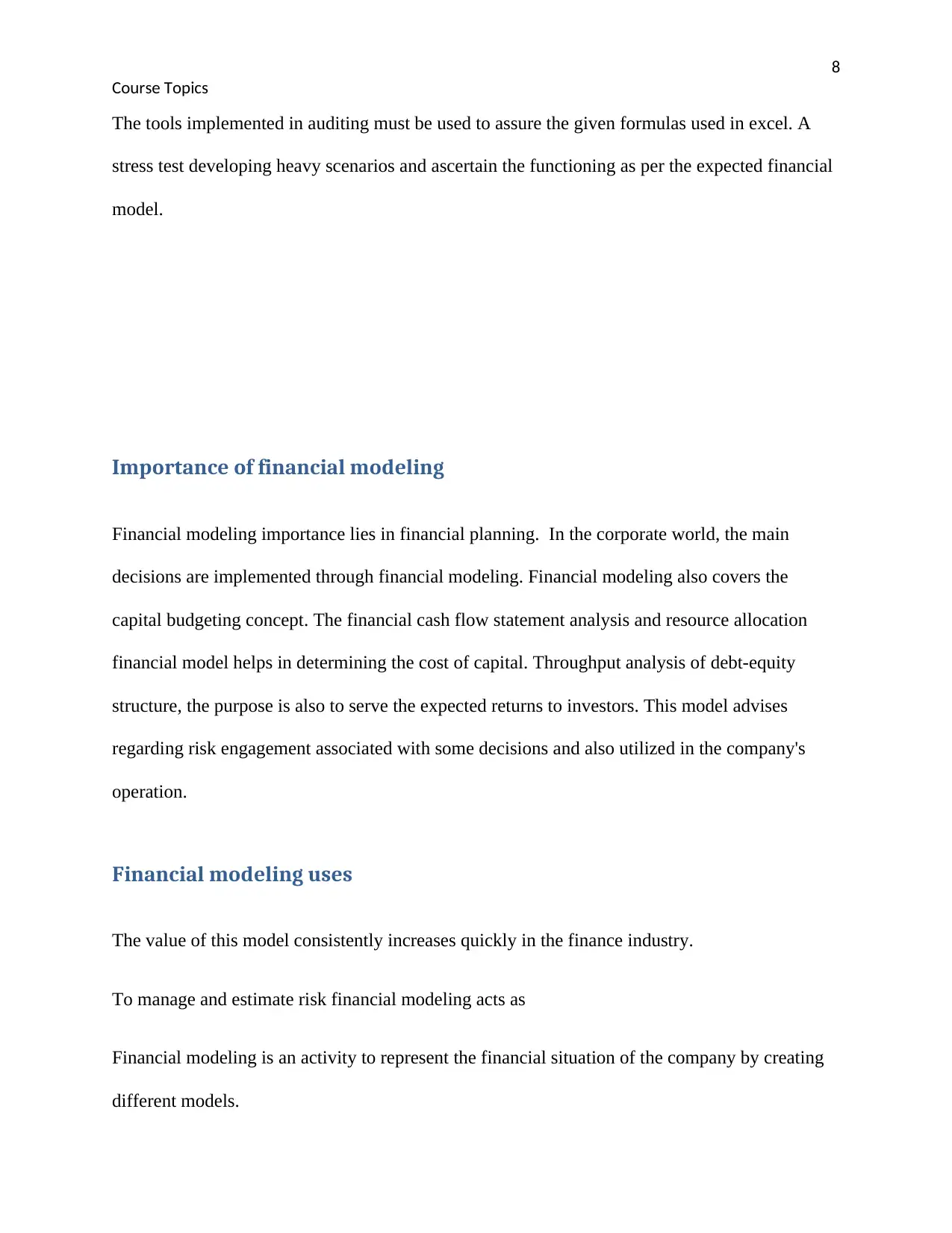
8
Course Topics
The tools implemented in auditing must be used to assure the given formulas used in excel. A
stress test developing heavy scenarios and ascertain the functioning as per the expected financial
model.
Importance of financial modeling
Financial modeling importance lies in financial planning. In the corporate world, the main
decisions are implemented through financial modeling. Financial modeling also covers the
capital budgeting concept. The financial cash flow statement analysis and resource allocation
financial model helps in determining the cost of capital. Throughput analysis of debt-equity
structure, the purpose is also to serve the expected returns to investors. This model advises
regarding risk engagement associated with some decisions and also utilized in the company's
operation.
Financial modeling uses
The value of this model consistently increases quickly in the finance industry.
To manage and estimate risk financial modeling acts as
Financial modeling is an activity to represent the financial situation of the company by creating
different models.
Course Topics
The tools implemented in auditing must be used to assure the given formulas used in excel. A
stress test developing heavy scenarios and ascertain the functioning as per the expected financial
model.
Importance of financial modeling
Financial modeling importance lies in financial planning. In the corporate world, the main
decisions are implemented through financial modeling. Financial modeling also covers the
capital budgeting concept. The financial cash flow statement analysis and resource allocation
financial model helps in determining the cost of capital. Throughput analysis of debt-equity
structure, the purpose is also to serve the expected returns to investors. This model advises
regarding risk engagement associated with some decisions and also utilized in the company's
operation.
Financial modeling uses
The value of this model consistently increases quickly in the finance industry.
To manage and estimate risk financial modeling acts as
Financial modeling is an activity to represent the financial situation of the company by creating
different models.
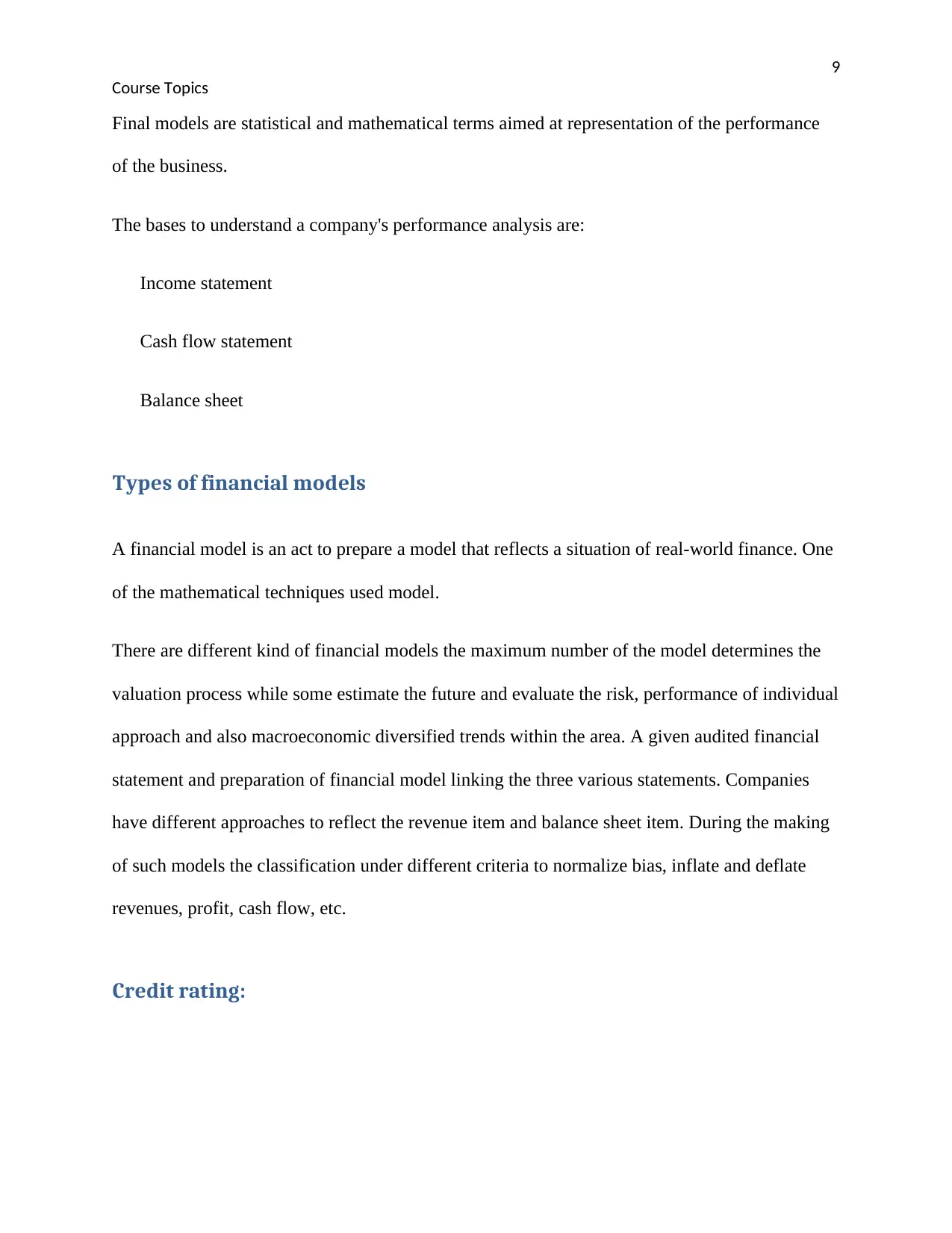
9
Course Topics
Final models are statistical and mathematical terms aimed at representation of the performance
of the business.
The bases to understand a company's performance analysis are:
Income statement
Cash flow statement
Balance sheet
Types of financial models
A financial model is an act to prepare a model that reflects a situation of real-world finance. One
of the mathematical techniques used model.
There are different kind of financial models the maximum number of the model determines the
valuation process while some estimate the future and evaluate the risk, performance of individual
approach and also macroeconomic diversified trends within the area. A given audited financial
statement and preparation of financial model linking the three various statements. Companies
have different approaches to reflect the revenue item and balance sheet item. During the making
of such models the classification under different criteria to normalize bias, inflate and deflate
revenues, profit, cash flow, etc.
Credit rating:
Course Topics
Final models are statistical and mathematical terms aimed at representation of the performance
of the business.
The bases to understand a company's performance analysis are:
Income statement
Cash flow statement
Balance sheet
Types of financial models
A financial model is an act to prepare a model that reflects a situation of real-world finance. One
of the mathematical techniques used model.
There are different kind of financial models the maximum number of the model determines the
valuation process while some estimate the future and evaluate the risk, performance of individual
approach and also macroeconomic diversified trends within the area. A given audited financial
statement and preparation of financial model linking the three various statements. Companies
have different approaches to reflect the revenue item and balance sheet item. During the making
of such models the classification under different criteria to normalize bias, inflate and deflate
revenues, profit, cash flow, etc.
Credit rating:
⊘ This is a preview!⊘
Do you want full access?
Subscribe today to unlock all pages.

Trusted by 1+ million students worldwide
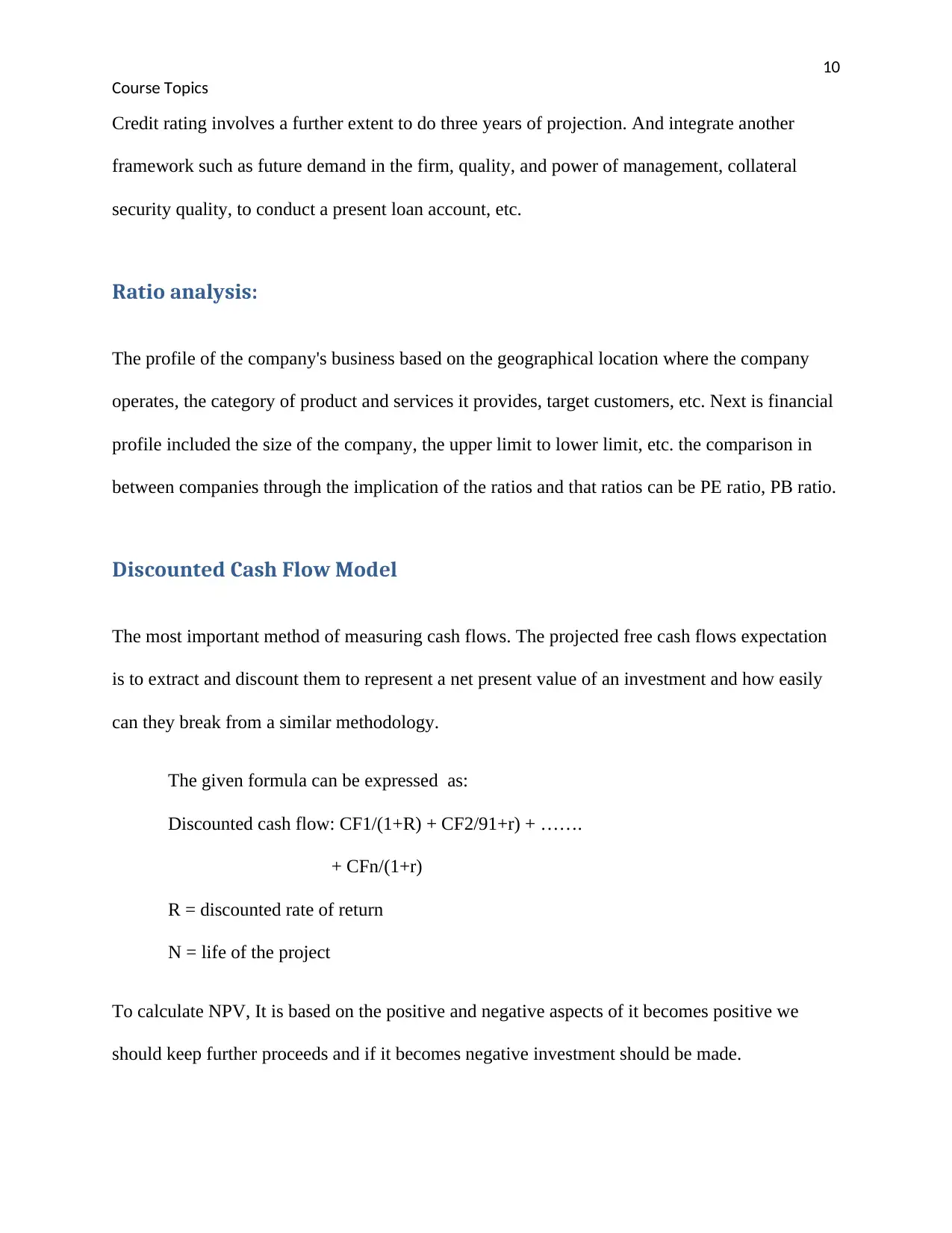
10
Course Topics
Credit rating involves a further extent to do three years of projection. And integrate another
framework such as future demand in the firm, quality, and power of management, collateral
security quality, to conduct a present loan account, etc.
Ratio analysis:
The profile of the company's business based on the geographical location where the company
operates, the category of product and services it provides, target customers, etc. Next is financial
profile included the size of the company, the upper limit to lower limit, etc. the comparison in
between companies through the implication of the ratios and that ratios can be PE ratio, PB ratio.
Discounted Cash Flow Model
The most important method of measuring cash flows. The projected free cash flows expectation
is to extract and discount them to represent a net present value of an investment and how easily
can they break from a similar methodology.
The given formula can be expressed as:
Discounted cash flow: CF1/(1+R) + CF2/91+r) + …….
+ CFn/(1+r)
R = discounted rate of return
N = life of the project
To calculate NPV, It is based on the positive and negative aspects of it becomes positive we
should keep further proceeds and if it becomes negative investment should be made.
Course Topics
Credit rating involves a further extent to do three years of projection. And integrate another
framework such as future demand in the firm, quality, and power of management, collateral
security quality, to conduct a present loan account, etc.
Ratio analysis:
The profile of the company's business based on the geographical location where the company
operates, the category of product and services it provides, target customers, etc. Next is financial
profile included the size of the company, the upper limit to lower limit, etc. the comparison in
between companies through the implication of the ratios and that ratios can be PE ratio, PB ratio.
Discounted Cash Flow Model
The most important method of measuring cash flows. The projected free cash flows expectation
is to extract and discount them to represent a net present value of an investment and how easily
can they break from a similar methodology.
The given formula can be expressed as:
Discounted cash flow: CF1/(1+R) + CF2/91+r) + …….
+ CFn/(1+r)
R = discounted rate of return
N = life of the project
To calculate NPV, It is based on the positive and negative aspects of it becomes positive we
should keep further proceeds and if it becomes negative investment should be made.
Paraphrase This Document
Need a fresh take? Get an instant paraphrase of this document with our AI Paraphraser
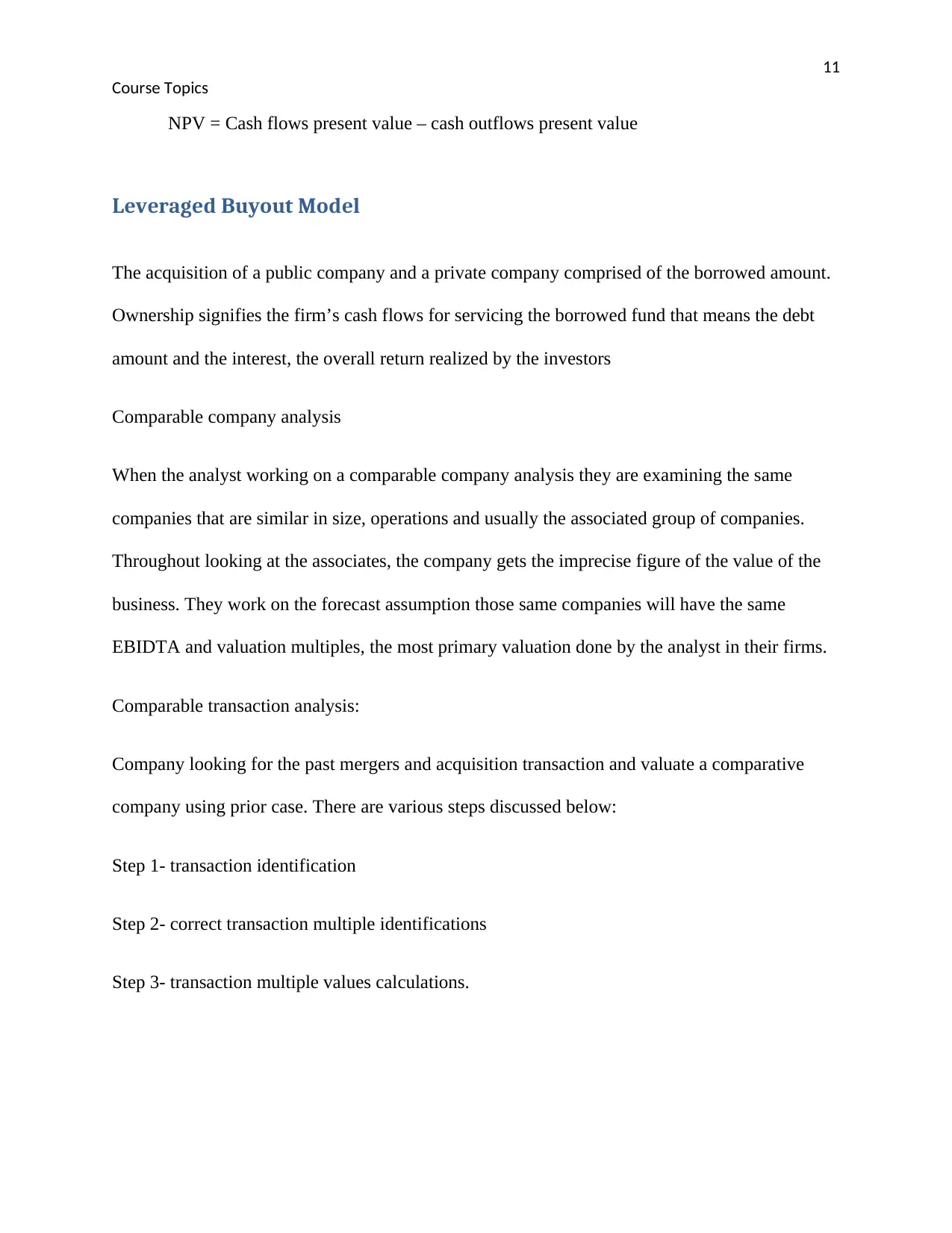
11
Course Topics
NPV = Cash flows present value – cash outflows present value
Leveraged Buyout Model
The acquisition of a public company and a private company comprised of the borrowed amount.
Ownership signifies the firm’s cash flows for servicing the borrowed fund that means the debt
amount and the interest, the overall return realized by the investors
Comparable company analysis
When the analyst working on a comparable company analysis they are examining the same
companies that are similar in size, operations and usually the associated group of companies.
Throughout looking at the associates, the company gets the imprecise figure of the value of the
business. They work on the forecast assumption those same companies will have the same
EBIDTA and valuation multiples, the most primary valuation done by the analyst in their firms.
Comparable transaction analysis:
Company looking for the past mergers and acquisition transaction and valuate a comparative
company using prior case. There are various steps discussed below:
Step 1- transaction identification
Step 2- correct transaction multiple identifications
Step 3- transaction multiple values calculations.
Course Topics
NPV = Cash flows present value – cash outflows present value
Leveraged Buyout Model
The acquisition of a public company and a private company comprised of the borrowed amount.
Ownership signifies the firm’s cash flows for servicing the borrowed fund that means the debt
amount and the interest, the overall return realized by the investors
Comparable company analysis
When the analyst working on a comparable company analysis they are examining the same
companies that are similar in size, operations and usually the associated group of companies.
Throughout looking at the associates, the company gets the imprecise figure of the value of the
business. They work on the forecast assumption those same companies will have the same
EBIDTA and valuation multiples, the most primary valuation done by the analyst in their firms.
Comparable transaction analysis:
Company looking for the past mergers and acquisition transaction and valuate a comparative
company using prior case. There are various steps discussed below:
Step 1- transaction identification
Step 2- correct transaction multiple identifications
Step 3- transaction multiple values calculations.
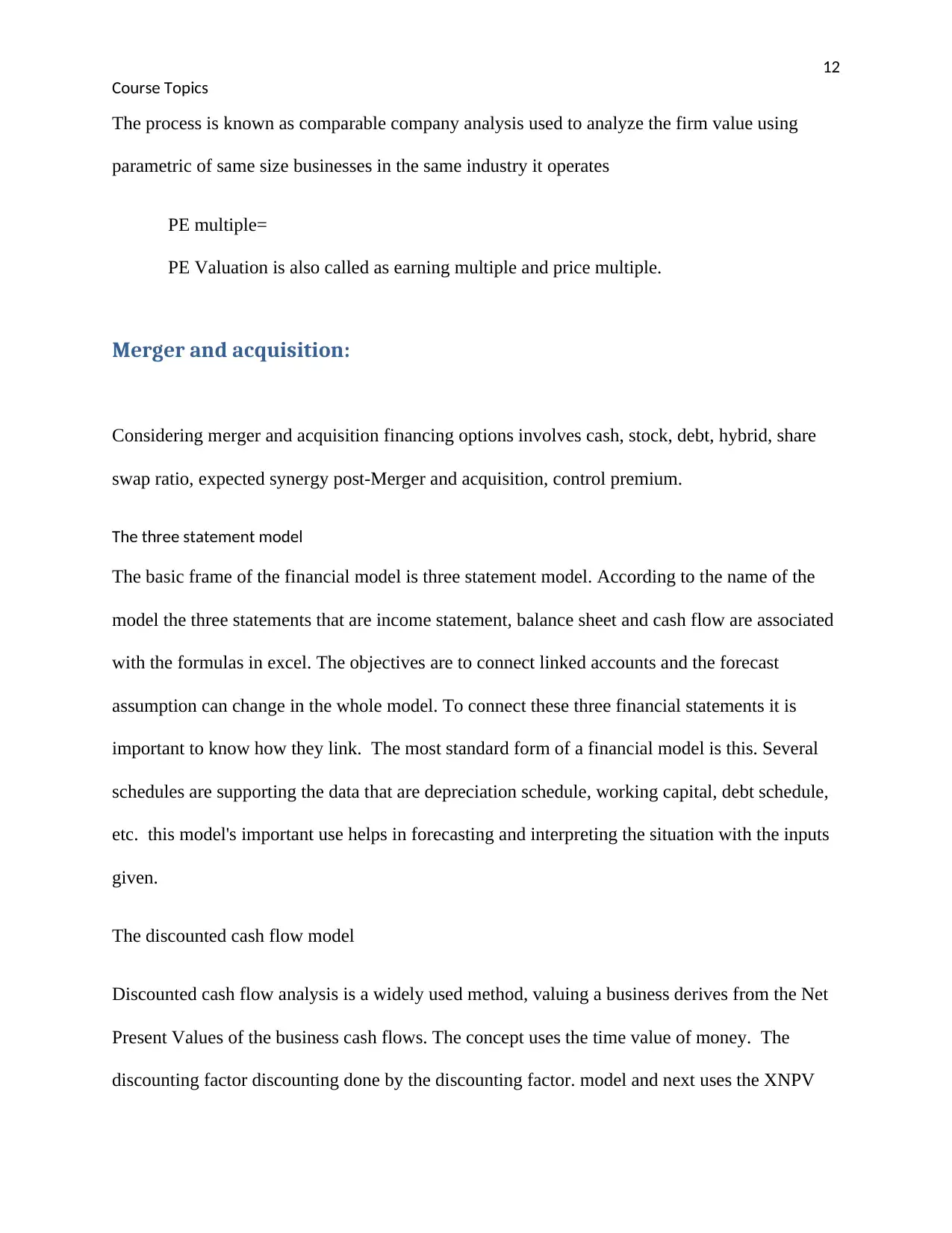
12
Course Topics
The process is known as comparable company analysis used to analyze the firm value using
parametric of same size businesses in the same industry it operates
PE multiple=
PE Valuation is also called as earning multiple and price multiple.
Merger and acquisition:
Considering merger and acquisition financing options involves cash, stock, debt, hybrid, share
swap ratio, expected synergy post-Merger and acquisition, control premium.
The three statement model
The basic frame of the financial model is three statement model. According to the name of the
model the three statements that are income statement, balance sheet and cash flow are associated
with the formulas in excel. The objectives are to connect linked accounts and the forecast
assumption can change in the whole model. To connect these three financial statements it is
important to know how they link. The most standard form of a financial model is this. Several
schedules are supporting the data that are depreciation schedule, working capital, debt schedule,
etc. this model's important use helps in forecasting and interpreting the situation with the inputs
given.
The discounted cash flow model
Discounted cash flow analysis is a widely used method, valuing a business derives from the Net
Present Values of the business cash flows. The concept uses the time value of money. The
discounting factor discounting done by the discounting factor. model and next uses the XNPV
Course Topics
The process is known as comparable company analysis used to analyze the firm value using
parametric of same size businesses in the same industry it operates
PE multiple=
PE Valuation is also called as earning multiple and price multiple.
Merger and acquisition:
Considering merger and acquisition financing options involves cash, stock, debt, hybrid, share
swap ratio, expected synergy post-Merger and acquisition, control premium.
The three statement model
The basic frame of the financial model is three statement model. According to the name of the
model the three statements that are income statement, balance sheet and cash flow are associated
with the formulas in excel. The objectives are to connect linked accounts and the forecast
assumption can change in the whole model. To connect these three financial statements it is
important to know how they link. The most standard form of a financial model is this. Several
schedules are supporting the data that are depreciation schedule, working capital, debt schedule,
etc. this model's important use helps in forecasting and interpreting the situation with the inputs
given.
The discounted cash flow model
Discounted cash flow analysis is a widely used method, valuing a business derives from the Net
Present Values of the business cash flows. The concept uses the time value of money. The
discounting factor discounting done by the discounting factor. model and next uses the XNPV
⊘ This is a preview!⊘
Do you want full access?
Subscribe today to unlock all pages.

Trusted by 1+ million students worldwide
1 out of 19
Related Documents
Your All-in-One AI-Powered Toolkit for Academic Success.
+13062052269
info@desklib.com
Available 24*7 on WhatsApp / Email
![[object Object]](/_next/static/media/star-bottom.7253800d.svg)
Unlock your academic potential
Copyright © 2020–2025 A2Z Services. All Rights Reserved. Developed and managed by ZUCOL.





